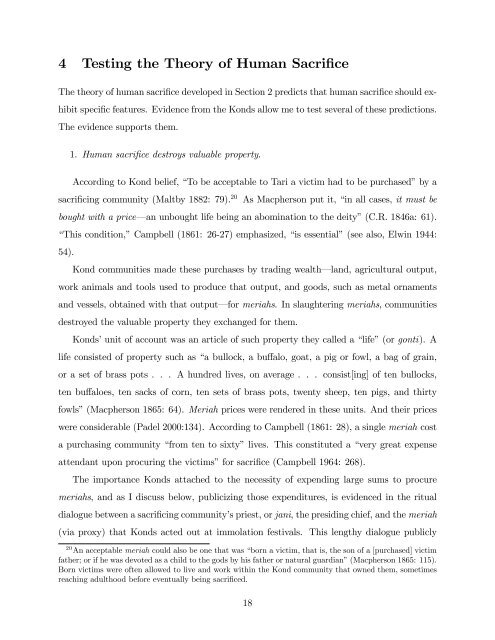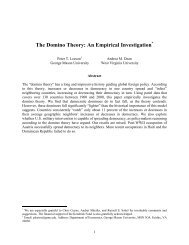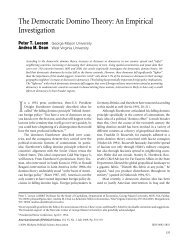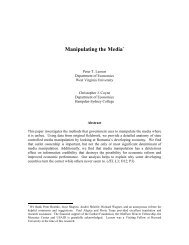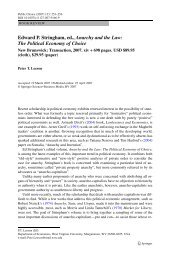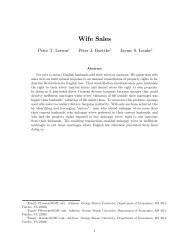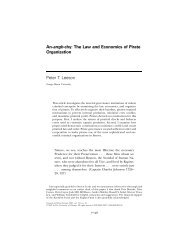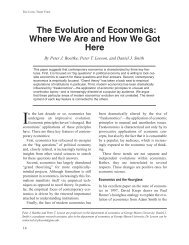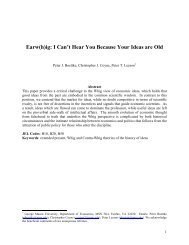Human Sacrifice - Peter Leeson
Human Sacrifice - Peter Leeson
Human Sacrifice - Peter Leeson
You also want an ePaper? Increase the reach of your titles
YUMPU automatically turns print PDFs into web optimized ePapers that Google loves.
4 Testing the Theory of <strong>Human</strong> Sacri…ce<br />
The theory of human sacri…ce developed in Section 2 predicts that human sacri…ce should exhibit<br />
speci…c features. Evidence from the Konds allow me to test several of these predictions.<br />
The evidence supports them.<br />
1. <strong>Human</strong> sacri…ce destroys valuable property.<br />
According to Kond belief, “To be acceptable to Tari a victim had to be purchased”by a<br />
sacri…cing community (Maltby 1882: 79). 20<br />
As Macpherson put it, “in all cases, it must be<br />
bought with a price— an unbought life being an abomination to the deity”(C.R. 1846a: 61).<br />
“This condition,”Campbell (1861: 26-27) emphasized, “is essential”(see also, Elwin 1944:<br />
54).<br />
Kond communities made these purchases by trading wealth— land, agricultural output,<br />
work animals and tools used to produce that output, and goods, such as metal ornaments<br />
and vessels, obtained with that output— for meriahs. In slaughtering meriahs, communities<br />
destroyed the valuable property they exchanged for them.<br />
Konds’unit of account was an article of such property they called a “life”(or gonti). A<br />
life consisted of property such as “a bullock, a bu¤alo, goat, a pig or fowl, a bag of grain,<br />
or a set of brass pots . . . A hundred lives, on average . . . consist[ing] of ten bullocks,<br />
ten bu¤aloes, ten sacks of corn, ten sets of brass pots, twenty sheep, ten pigs, and thirty<br />
fowls”(Macpherson 1865: 64). Meriah prices were rendered in these units. And their prices<br />
were considerable (Padel 2000:134). According to Campbell (1861: 28), a single meriah cost<br />
a purchasing community “from ten to sixty” lives. This constituted a “very great expense<br />
attendant upon procuring the victims”for sacri…ce (Campbell 1964: 268).<br />
The importance Konds attached to the necessity of expending large sums to procure<br />
meriahs, and as I discuss below, publicizing those expenditures, is evidenced in the ritual<br />
dialogue between a sacri…cing community’s priest, or jani, the presiding chief, and the meriah<br />
(via proxy) that Konds acted out at immolation festivals. This lengthy dialogue publicly<br />
20 An acceptable meriah could also be one that was “born a victim, that is, the son of a [purchased] victim<br />
father; or if he was devoted as a child to the gods by his father or natural guardian”(Macpherson 1865: 115).<br />
Born victims were often allowed to live and work within the Kond community that owned them, sometimes<br />
reaching adulthood before eventually being sacri…ced.<br />
18


